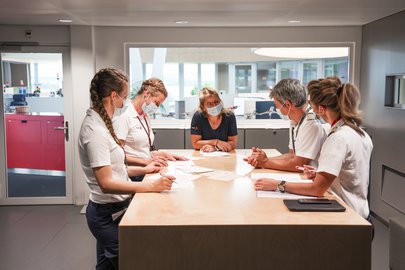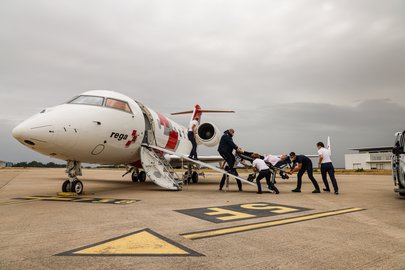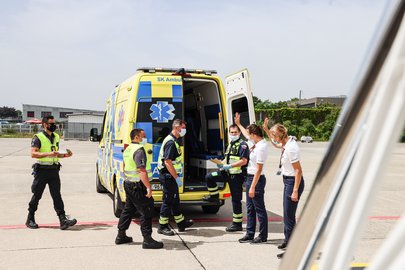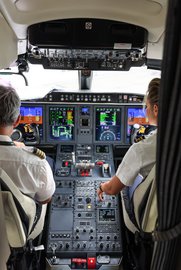Four days before the mission, the father of 17-year-old Owen contacts Rega from a hospital near Cannes. A few days earlier, his son had been diagnosed with internal bleeding, the causes of which are still unclear. Since then, the Rega medical consultant has been in close contact with the father and the local doctors – because before a Rega jet takes off on a mission, a thorough medical assessment needs to be carried out. It soon becomes clear that returning to Switzerland by land would be too risky due to the unexplained medical situation, so the medical consultant opts for repatriation in the Rega ambulance jet. What no one knows at this time is that Owen will not be the only patient on this flight back to Switzerland.
Not far from the young man, in Nîmes, another Rega patron is in hospital care: he had fallen off his motorbike after steering it into a bed of gravel at around 100 kilometres per hour and had suffered serious injuries. At the emergency unit in France, he was diagnosed with a broken collarbone, four broken ribs and a pulmonary contusion. A deterioration in his condition in the next hours and days cannot be ruled out due to the injuries in the chest area, so Rega’s medical consultants decide to repatriate him by ambulance jet as well. Based on their current locations and their diagnoses, the two patients can be flown back to Switzerland together. On around every third repatriation mission by Rega jet, two – or in exceptional cases more – patients are flown home at the same time.
The repatriation of the two patients is scheduled for the following day. A complex preparation process now begins for the flight coordinator at the Rega Centre, for unlike a repatriation with just one patient, several patient transports on the ground and several take-offs and landings have to be organised and coordinated. The flight coordinator draws up a time schedule, mobilises the crew and starts organising ambulances both in the south of France and in Switzerland. These are to transport the two patients to the Rega jet in France and later to the destination hospitals in Switzerland. Meanwhile, the dispatcher at the Operations Centre determines the flight routes, taking into account the wind and weather conditions, and calculates how much fuel is required.
Preparation for a problem-free mission
The next morning, intensive care nurse Karine Lang and flight physician Eliane Dössegger prepare for the mission in the medicine room in the hangar at the Rega Centre. They need to take with them the correct medication and medical equipment for both patients. “We always have to remain flexible and be able to react quickly to unforeseen situations,” explains Karine Lang. At the same time, pilot Stefan Hug and co-pilot Annika Berner discuss the details of the flight, as well as the take-off and landing times. At eight o’clock on the dot, the entire crew meet for a joint briefing with the flight coordinator. Shortly before nine o’clock, the Rega jet takes off in the direction of the south coast of France and lands in Cannes just under an hour later.
Questions for the patient
Meanwhile, patient Owen is feeling a little better. However, the cause of the severe bleeding has still not been identified and his condition could deteriorate at any time. Until he is in the Rega jet, he is looked after by paramedics from the local ambulance service. After Owen is handed over to the Rega crew, Eliane Dössegger and Karine Lang check his medical condition and ask him a few simple questions – such as about today’s date or why he is being repatriated. “If possible, I do this with all my patients,” says Eliane Dössegger. “It helps us to understand their current condition and gives us an idea of their mental state, so we can provide them with the best possible care during the flight.” A few minutes earlier than planned, the ambulance jet takes off for Nîmes.
At the right place at the right time
The flight goes off without a hitch and soon the Rega jet is taxiing to its stand at the airport. Just a few minutes later, the blue and white ambulance vehicle appears with the second patient of the day. Just enough time for Stefan Hug and Annika Berner to unfold the ramp, which was specially designed for the Rega jets, via which the patient, lying on a stretcher trolley, is subsequently pushed into the jet. The 58-year-old man is tired but visibly relieved that he is now going home. The medical crew and patients are ready for the flight, so Eliane Dössegger and Karine Lang give the go-ahead to the pilots in the cockpit. So far the mission is running smoothly, and the Rega crew is now 30 minutes ahead of schedule. The flight coordinator at the Rega Centre therefore informs the ambulance services in Western Switzerland and Zurich of the new arrival times. Thanks to this information, an ambulance is waiting for the Rega crew in Geneva in good time, ready to take patient Owen to hospital.
After the mission is before the mission
Before the last take-off of the day, Karine Lang checks the condition of the second patient once again. Until now he has been fast asleep and will also spend the final, short flight from Geneva to Zurich asleep. His condition is stable, and an ambulance will be waiting for him in the hangar of the Rega Centre to transport him to hospital. Shortly before landing, however, he does wake up. “We’re almost home,” Eliane Dössegger tells him, just before the jet touches down on runway 14. In the Rega hangar, the crew say goodbye to the patient before he sets out on the short journey to hospital by ambulance.
But for the four-person crew, the working day is not yet over. In the hangar at the Rega Centre, they make sure that the jet is ready again for the next mission. At the subsequent debriefing, the crew members discuss the past hours. The collaboration and communication with the Operations Centre had worked extremely well. As they leave the briefing room, the next repatriations are already being planned in the Operations Centre.




